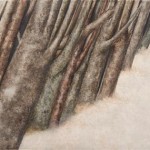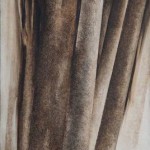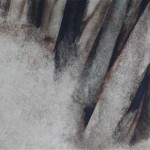Sohrab Sepehri’s painting is characterized by the supremacy of the subjective imagination over the concrete representation. His vision favors fantasy over both reason and feeling. Much like Romantic artists, to him, the way to a profound perception of the reality goes through imagination rather than intellect. Everything in the world is existentially interconnected, and only a pure artistic imagination can perceive and represent such harmony. The present piece best exemplifies such instinctive attitude: an intuitive insight, a disclosure, to which Darioush Shaygan refers as the “space beyond”, where the “causal links of the tangible world no longer exist, and the logical sequence of time and the stability of geometric shapes are vanished[1]”
Abstraction in Sepehri’s work is not pushed to its limits. As a poet, he could hardly dismiss the subject-matter. Any brushstroke thus combines visual quality with literary connotation. The subject-matter in the present piece is depicted in most elusive manner: the colossal shadow evokes various associations; the earth, a mountain, horizon, a flower; its continuous alteration making any definite interpretation impossible.
Such a sensational approach towards depicting the nature arrives after episodes of abstraction in the artist’s career. He resumes a semi-representational approach while retaining his inner involvement with abstraction. The vigorous presence of geometric elements and their role in the expressive power of the painting clearly reveal such transition from an abstract phase, while the forms are at this time imbued with a turbulent, excited energy which will not submit to any structural rationality.
The grayish shade sweeping the background is Sepehri’s favorite tone. The vertical movement of the color black and its passage from bottom to the top of the canvass closely reminds Japanese ink painting. The vivid red touches are traceable in many of the artist’s oil paintings. Their blazing red against black might suggest anemones. The main expressive element, however, is the massive brown field of color, expanded as to cover the width of the painting. The field of color is painted with strong, confident brushstrokes, with such swiftness that clearly indicates the artist’s emotional outpour. The awesome field recalls a loud echo, a resonating sound; as the sound also plays a weighty role in the artist’s poems. This could be read as a manifestation of the Sublime, the mysterious, the shadow of a profound experience, or a confrontation with a greater truth beyond the nature. As found in Sohrab Sepehri’s poems, this might be interpreted as the union of the existence, or the mystery of death: “the wings of life are wide as death[2]”.
Sohrab Sepehri’s palette is also unique. M.A. Sepanloo, Iranian renowned poet and scholar, has called his colors “the spectrum of Iranian climate”, which through them, “a share of Iranian soul continues to live in Sohrab’s art.”[3] The palette usually includes a variety of browns, black, and blazing red or turquoise touches on a tinted gray background. Free rendering grants the composition the spontaneity of a sketch, but marked with unexpected persuasive strength and assertiveness. Karim Imami, Iranian art critic, exalted Sohrab for his swiftness, dexterity and disregard for minor details: “he trained his eyes to see but the principal shapes,… to reach the main essence of the things”[4]. Although Sohrab’s paintings are uninhabited by any human figure, all he depicts is infused with humane expressions. Any touch represents a word, talking in the universal language of the nature. His paintings remind us of Japanese Haiku, free from the limits of time and place. Although Sohrab’s paintings might be seen as genuine personal accounts, they nevertheless seek universal audience.
[1] Shaygan, Darioush, “lahze I dar vaheh” (a moment in the oasis), in: Sohrab Sepehri, Poet and Painter, by Lili Golestan, Amir Kabir Publishers, 1980, p.38.
[2] Sepehri, Sohrab, ‘The Footsteps of Water’, from The Eight Volumes, 1965
[3] Sepanloo, M.A, “the poet inheres the water, light and reason”, in: Sohrab Sepehri, Poet and Painter, by Lili Golestan, Amir Kabir Publishers, 1980, p.42.
[4] Imami, Karim, “Selections: Beyond the song of the anemone: a survey on Sohrab Sepehri’s poems and paintings”, Iran Nameh, No. 18, Winter 1986, p. 330






